Blog Content
3
Jul
2025
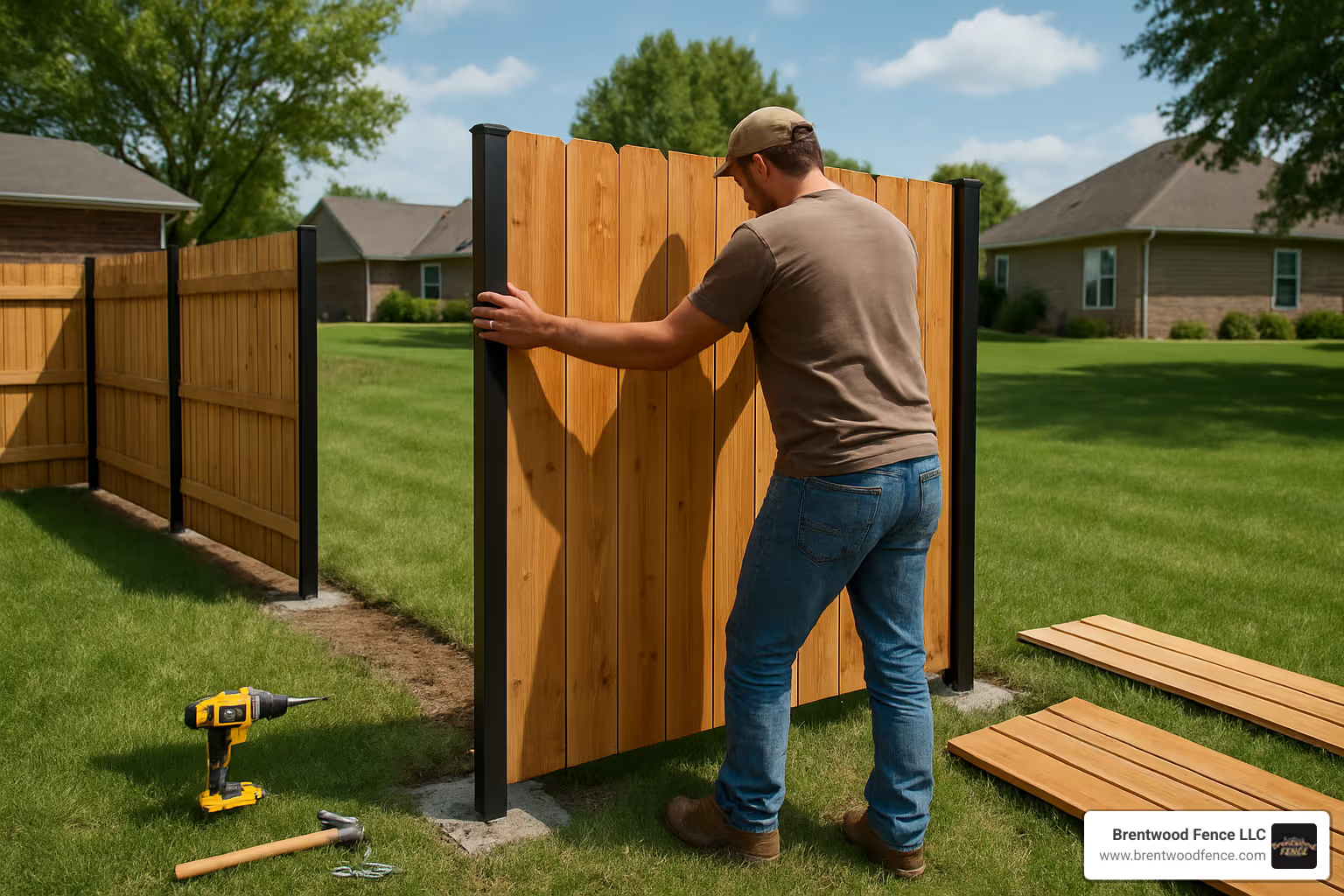
Installing wood fence panels with metal posts combines the natural beauty of wood with the strength and longevity of metal. This hybrid approach can extend your fence life by 2-4 times compared to traditional all-wood fences, while maintaining the classic aesthetic homeowners love.
Quick Answer: Installing Wood Fence Panels with Metal Posts
The average wooden fence post rots away in 7-10 years, but metal posts can last for decades with minimal maintenance. This means fewer repairs, lower long-term costs, and a fence that stays strong through storms and weather extremes.
Why homeowners choose this combination:
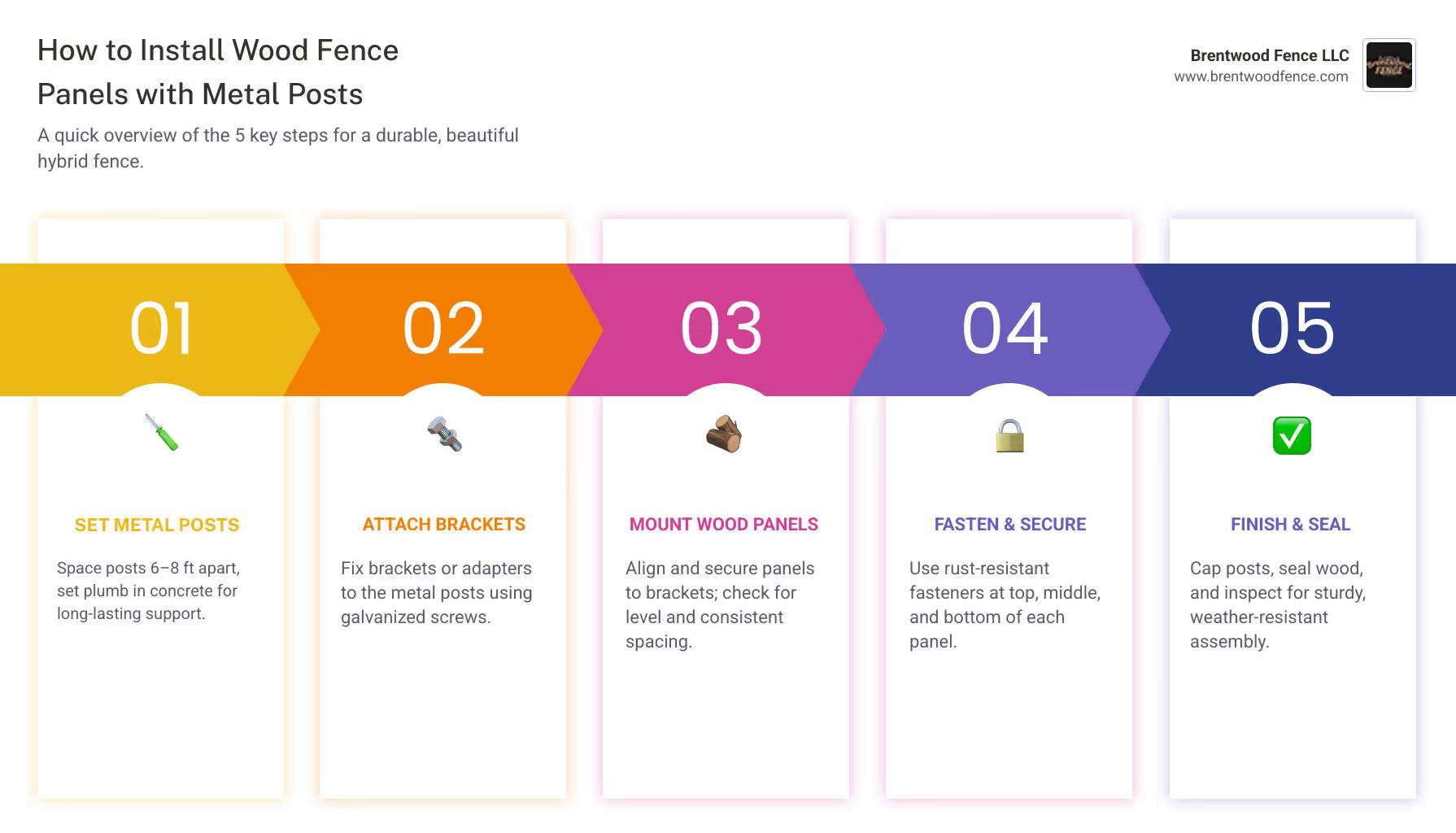
In this comprehensive guide, we'll walk you through the complete process of creating a durable wood-and-metal fence. You'll find the benefits of this hybrid approach, learn about proper planning and material selection, and get detailed step-by-step instructions for professional-quality installation.
When you're planning your fence installation, installing wood fence panels with metal posts creates a fence system that dramatically outperforms traditional methods. While wooden posts typically rot away in 7-10 years, metal posts can extend your fence life by 2 to 4 times that duration.
The secret lies in what happens underground. Traditional wood posts sit buried in soil where moisture, insects, and fungi wage a constant battle against the wood fibers. Metal posts are designed to withstand these exact challenges without breaking down.
Galvanized steel posts bring serious structural advantages to your fence line. They provide superior wind-load strength that becomes especially valuable during fierce winter storms in New Hampshire, Massachusetts, and Maine. A properly installed metal post anchored in concrete creates a foundation that can support heavy wood panels without the sagging or shifting that plague aging wooden posts.
According to scientific research on post-rot decline, the underground portion of wooden posts faces the greatest risk of deterioration. This is where metal posts truly shine, maintaining their structural integrity even when buried for decades.
For homeowners considering professional installation, understanding these material advantages helps explain why many professional fence installation projects now incorporate metal posts even when clients want the natural beauty of wood panels.
The extended lifespan of metal posts translates into real cost savings over time. Storm survival becomes a major advantage when severe weather hits. Metal posts set in concrete provide a foundation that can withstand extreme weather events that might topple or damage all-wood fences.
This hybrid approach does come with some considerations. Mixed-material movement can occur as wood and metal expand and contract at different rates. Bracket and adapter costs do add to your initial investment, but these specialized components are essential for creating secure, long-lasting connections.
Getting your fence project right starts with solid planning. Check building codes and permit requirements with your local building department. Most areas require permits for new fence installations.
Post spacing should be 6-8 feet apart for most wood fence panels. This distance gives you proper support without panels sagging over time. If you live in an area with strong winds, consider 6-foot spacing for extra stability.
Material selection offers two main choices for metal posts: galvanized steel and powder-coated posts. Galvanized posts offer excellent rust resistance at a reasonable price. Powder-coated posts cost more but provide color options and a polished look.
Specialized systems like PostMaster or Z-Post come with built-in bracket attachment points, which means less guesswork and more reliable connections.
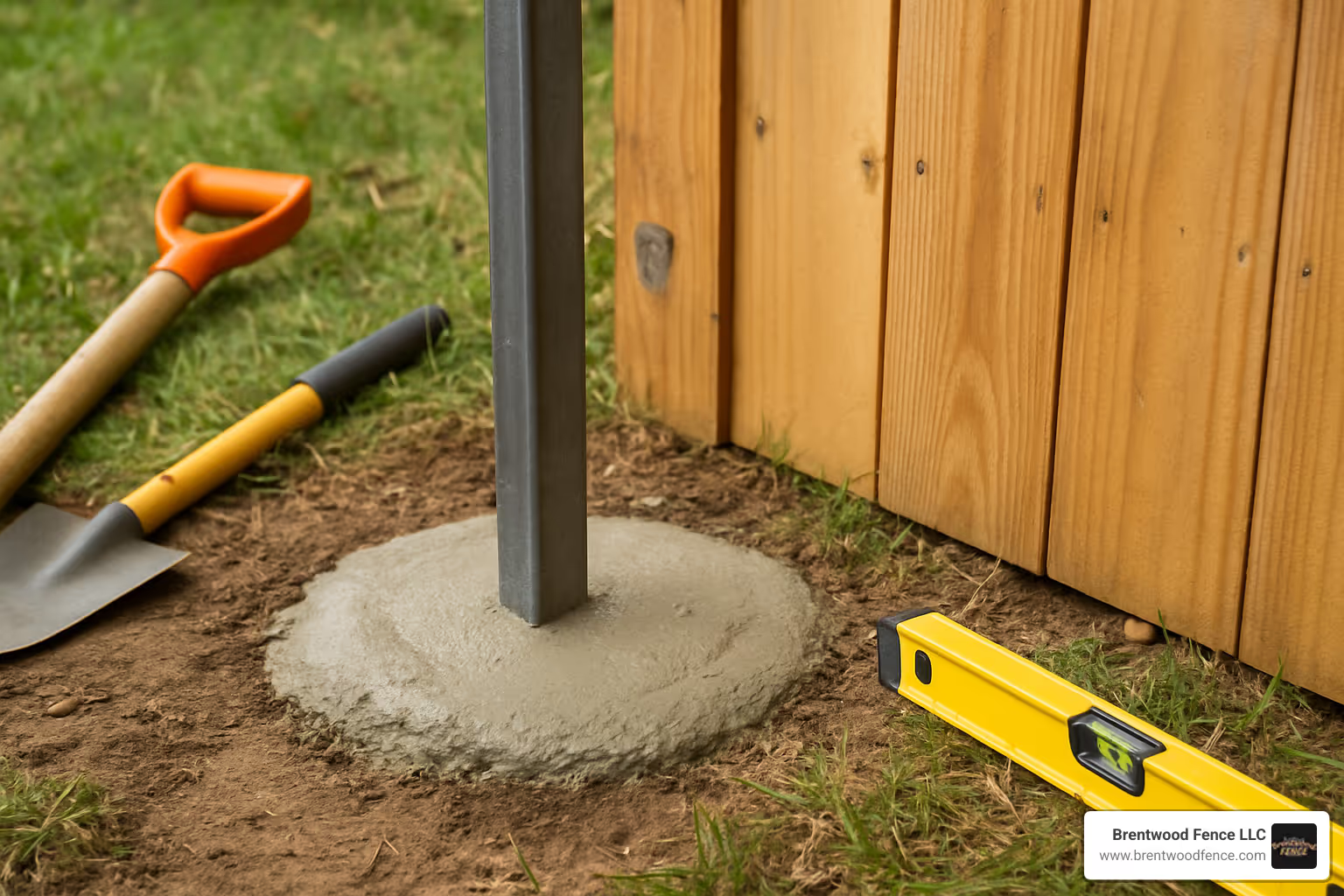
The hardware requires galvanized pressed-steel adapters in different styles—corner brackets for turns, end brackets for fence terminations, and line brackets for straight runs. Self-tapping screws designed for metal-to-wood connections eliminate the need for pre-drilling in most cases.
For setting posts, choose between concrete or gravel bases. Concrete gives maximum stability for heavy wood panels. Don't forget personal protective equipment (PPE) and tools including a post-hole digger, level, drill with bits, and concrete mixer.
Call 811 to have underground utilities marked before digging. This free service prevents dangerous and expensive accidents. Layout starts with a straight fence line using stakes and mason's string. Slope assessment determines whether you'll step your fence sections or rack them following the ground contour.
Bracket selection depends on your fence design. Line brackets handle straight sections, corner brackets manage turns, and end brackets finish fence runs. Rust-proof fasteners are essential—use galvanized or stainless steel screws to prevent rust stains and maintain strong connections.
For professional installation services, consider experienced contractors who specialize in Wood Fencing Installation Services.
Installing wood fence panels with metal posts requires a methodical approach that builds strength from the ground up. You'll start by creating solid anchor points with metal posts, then build outward with brackets and panels.
Professional installers follow this sequence because it works. The key is patience during concrete curing and precision during alignment. The entire process typically takes a weekend for most residential fence projects.
Getting your metal posts set properly is critical for installing wood fence panels with metal posts successfully. Post hole depth should equal one-third of your fence height plus 6 inches. For a standard 6-foot privacy fence, you'll be digging holes 30 inches deep.
Create a bell-shaped footer by widening the bottom of each hole. Use your post hole digger to flare out the bottom 4-6 inches wider than the top. This expanded base prevents posts from tipping.
Check your local frost line requirements before digging. In northern New Hampshire, Maine, and Massachusetts, frost lines can extend 4 feet or more below ground. Setting posts below the frost line prevents seasonal heaving.
Add 4-6 inches of tamped gravel at the bottom of each hole for drainage. This prevents water from pooling around the post base.
When setting posts, use quick-set concrete for convenience. Position your post in the center, pour dry concrete mix around it, add water according to package directions, and use a post level to ensure it's plumb in both directions.
Allow full cure time of 24-48 hours before attaching fence panels. The concrete needs time to reach full strength, especially for heavy wood panels.
Once your metal posts have fully cured, it's time to create connection points for your wood panels. Modern self-tapping screws have simplified this process by cutting their own threads as they drive into metal posts.
Two screws per bracket connection is the golden rule for secure attachment. Position screws to distribute load evenly—typically one near the top and one near the bottom of each mounting point.
Universal brackets work with various post shapes and sizes, making them versatile for mixed installations. Specialized brackets are designed for specific post profiles and offer a more precise fit.
Consistent bracket height makes or breaks the professional appearance of your finished fence. Use a string line stretched between end posts or a laser level to mark bracket positions before drilling. Mark all bracket positions first, then install them in sequence.
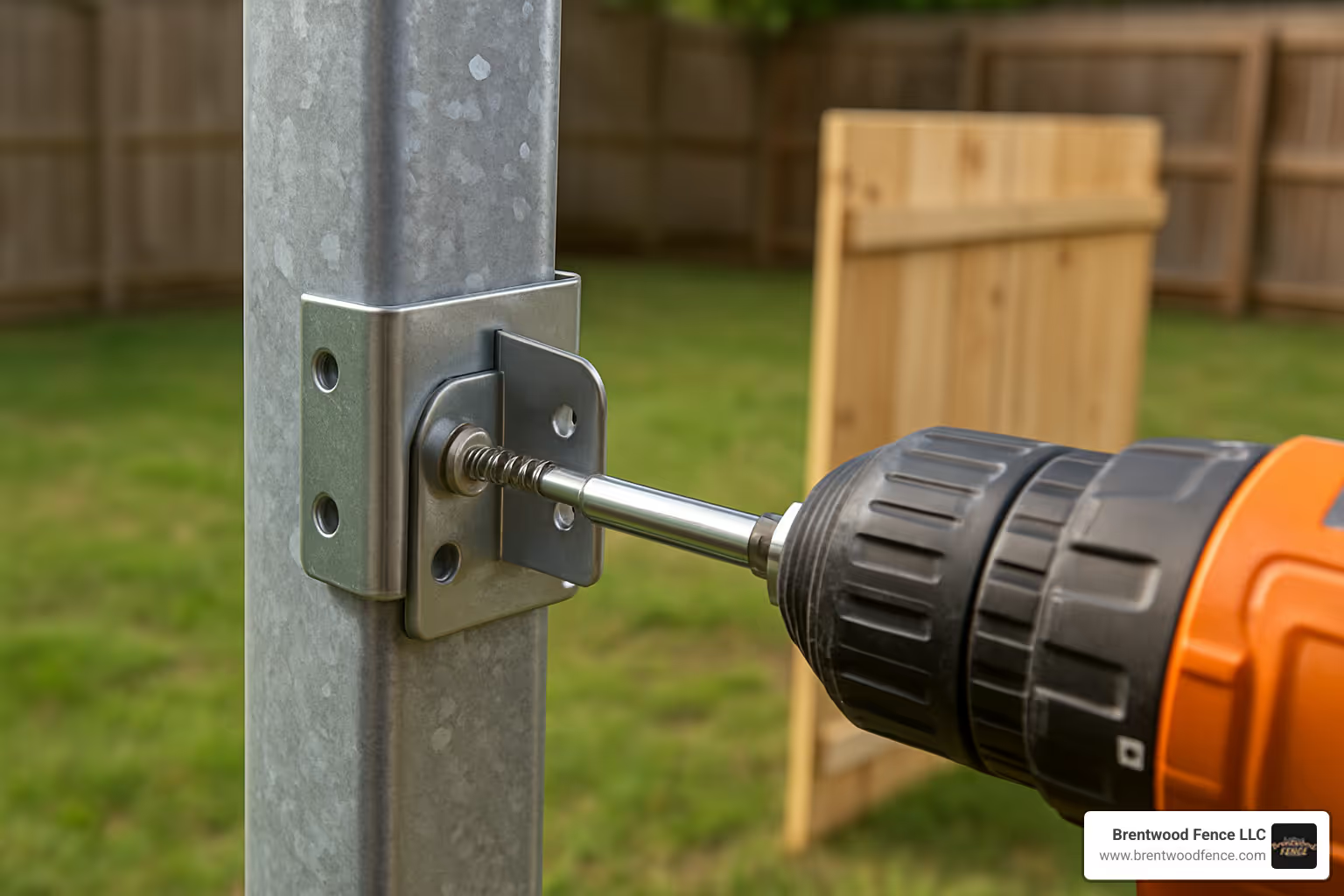
Installing wood fence panels with metal posts requires precision and patience. Start by positioning your first panel against the brackets, but check that it's perfectly level before securing. Use shims to level things out if posts aren't exactly the same height.
The screw pattern is crucial for long-term success. Use fasteners at the top, middle, and bottom of each panel connection. This three-point attachment system distributes wind loads evenly and prevents panel sag.
Use spacer blocks at corner posts before driving screws to prevent wood from splitting. Alignment is everything in fence installation—check your work frequently as you go. Each panel should have consistent gaps for natural wood expansion and contraction.
Working with sloped terrain when installing wood fence panels with metal posts means choosing between stepping or racking your fence sections.
Stepping creates a stair-step effect where each panel maintains the same height but sits at different elevations. This works well on moderate slopes and gives a clean, uniform look with gaps under lower panels.
Racking angles the panels to follow ground contours, creating a smooth fence line without gaps. This requires more precise cutting and works best on gentle, consistent slopes.
For stepping installations, trim panel bottoms to maintain about 2 inches of ground clearance throughout. Adjustable brackets can help with moderate slopes, allowing panels to angle while keeping secure connections to vertical posts.
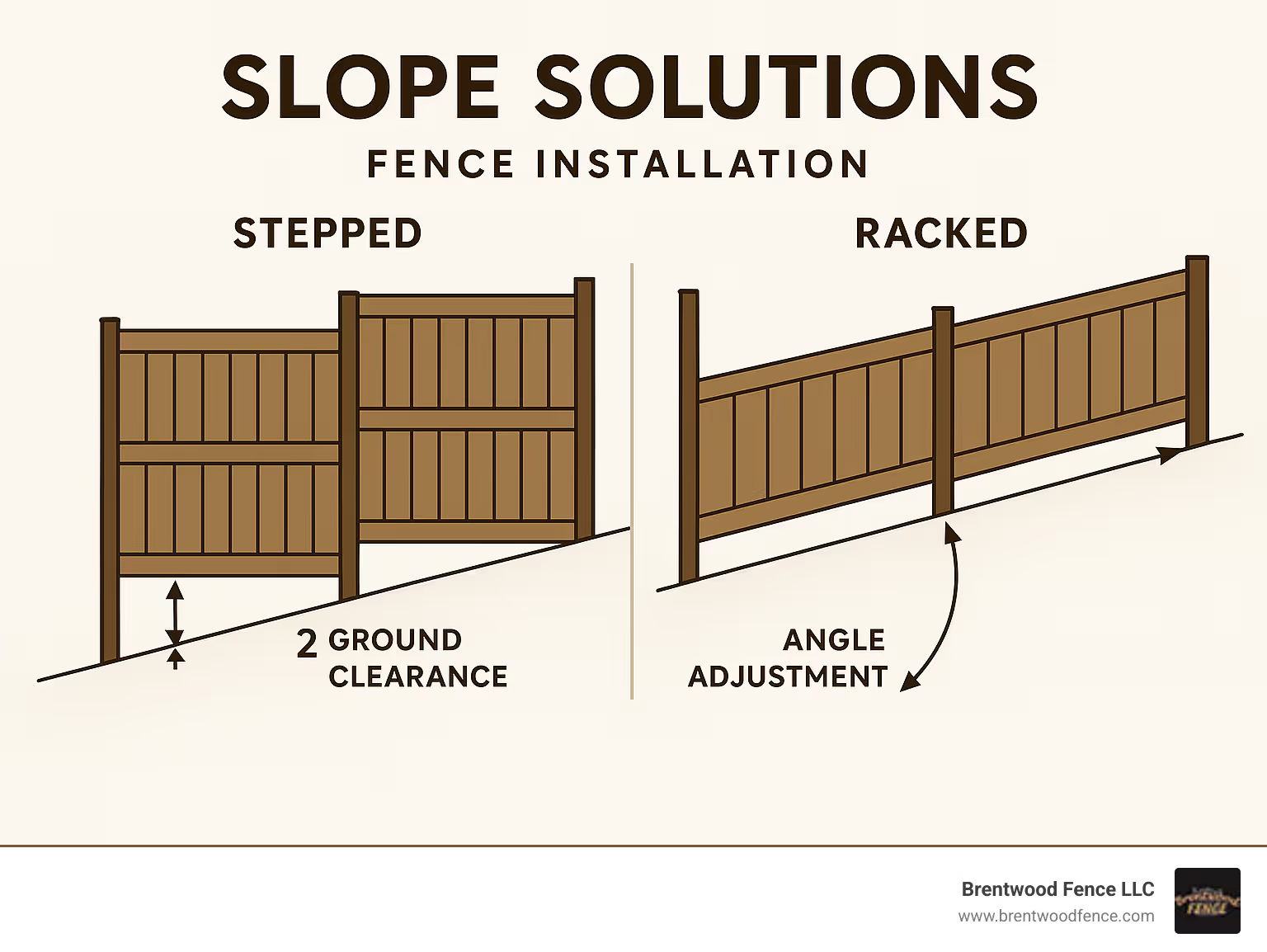
These final checks make the difference between a fence that looks good today and one that stays strong for decades. Start with a torque test on every connection. Hand-tighten each screw until snug, then give it just a quarter turn more with your drill on low speed.
Walk the entire fence line and give each panel a gentle shake. Everything should feel solid and stable. Gate alignment deserves special attention since gates get more use and stress. Check that gate posts are perfectly plumb in both directions.
Post-cap sealant is crucial for long-term performance. Apply a bead of quality exterior sealant around each post cap, smoothing it to shed water effectively. Take a step back and look at your completed fence from different angles—panels should appear level and evenly spaced.
This attention to detail ensures that installing wood fence panels with metal posts results in a fence that performs reliably for years to come. Learn about our professional fence installation services in NH, MA and ME.
Staining or sealing wood panels should be your first priority after installation. Apply high-quality exterior wood stain or sealant to all surfaces, including backs and edges of panels. This complete coverage creates a moisture barrier that extends wood life significantly.
Color-matching your metal posts to wood panels creates a cohesive, professional appearance. Use exterior-grade paint designed for metal surfaces, and don't skip primer on galvanized posts.
Post caps serve double duty by protecting your investment and adding visual appeal. They prevent water from entering the top of metal posts, which could cause internal corrosion. Install them with appropriate sealant around mounting points.
Annual inspections take less than an hour and can save significant money. Walk your fence line once a year, checking for loose fasteners, damaged wood, or early signs of corrosion. Proper grading around fence posts matters—water should drain away from the fence line, not pool around posts.
UV blockers in quality wood stains are worth the extra cost. Plan to reapply protective finishes every 2-3 years. Water management around your fence can make the difference between a 15-year fence and a 30-year fence.
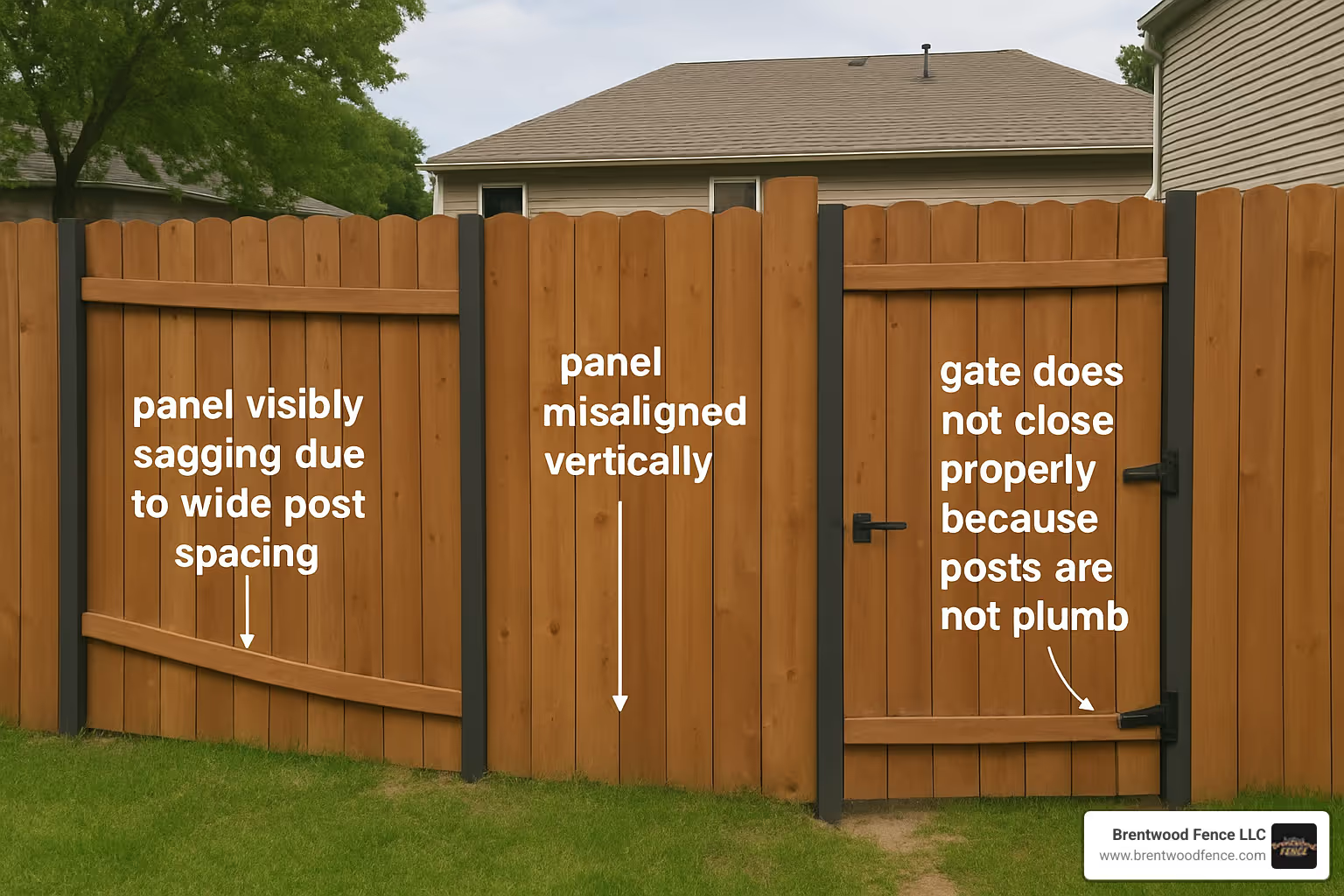
Even experienced DIYers can run into trouble when installing wood fence panels with metal posts. Most mistakes are preventable with proper planning.
Wrong post spacing tops the list of fence installation mistakes. Posts spaced too far apart create sagging panels. Posts too close together waste money and materials. Stick to that 6-8 foot spacing using a measuring tape, not guesswork.
Skipping concrete cure time comes back to haunt homeowners. Quick-set concrete hardens fast, but full strength takes 24-48 hours. Loading posts before they're ready can shift your perfectly aligned fence.
Mixing fastener types creates galvanic corrosion when different metals touch in moisture. Use galvanized steel fasteners throughout your project for consistent performance.
Ignoring local building codes can turn your weekend project into a costly nightmare. A quick call to your local building department saves you from expensive do-overs.
Not checking level frequently compounds small errors into big problems. Use a 4-foot level on individual posts and run a string line for long fence runs.
Skipping maintenance is perhaps the biggest mistake. Set up a simple maintenance schedule: inspect each spring, tighten loose fasteners, and reapply wood stain as needed.
Professional installation eliminates most of these mistakes. Sometimes the best DIY decision is knowing when to call in the pros. Learn about our professional fence installation services in NH, MA and ME.
You can attach wood panels to existing chain-link posts, but it depends on post size. Skinny 1-3/8" posts will bend under the weight of solid wood panels. However, sturdy 2-3/8" posts in good condition can support wood panels with the right hardware.
Universal panel adapters make this connection possible. Use tension bands with galvanized lag bolts instead of standard L-brackets. These wrap around the round post profile and provide multiple attachment points.
Installing wood fence panels with metal posts requires 6 to 8 feet between posts. Six-foot spacing provides maximum support and is best in high-wind areas. Eight-foot spacing works well for standard conditions and reduces project cost.
Consider your local wind zones when making this decision. High-wind areas benefit from the extra investment in 6-foot spacing.
Concrete provides maximum stability and is the go-to choice for heavy wood panels. It creates a solid anchor that won't shift under wind loads or freeze-thaw cycles.
Gravel-only installations offer excellent drainage and make future modifications easier. The key is depth and tamping—holes at least as deep as concrete installations, with gravel tamped in layers.
Foam setting products are convenient but best reserved for lighter applications. For most homeowners installing wood fence panels with metal posts, concrete remains the best choice.
Installing wood fence panels with metal posts creates a fence that truly gives you the best of both worlds. You get the warm, natural beauty of wood that makes your yard feel like home, combined with the rock-solid durability of metal that keeps your fence standing strong for decades.
Think about it—most wooden fence posts start rotting away after just 7-10 years, leaving you with wobbly panels and expensive repairs. But when you choose this hybrid approach, those metal posts can last 20-30 years or more, extending your fence life by 2-4 times. That's not just better performance; it's real money saved over the long haul.
The benefits go beyond just lasting longer. Metal posts resist rot, insects, and moisture damage that would destroy wooden posts, while your wood panels still provide the privacy and classic look that makes a fence both functional and beautiful. When storms roll through New Hampshire, Massachusetts, or Maine, you'll sleep better knowing your fence has the structural strength to weather whatever nature throws at it.
At Brentwood Fence LLC, we've seen how this combination transforms properties across our region. Homeowners tell us they love not having to worry about their fence every few years—no more replacing rotted posts, no more panels sagging in the wind, no more surprise repair bills.
Yes, the initial investment is slightly higher than traditional all-wood fencing. But when you factor in the reduced maintenance, extended lifespan, and superior storm resistance, this hybrid approach actually saves money while giving you better performance. It's the kind of smart investment that pays dividends for decades.
Your fence isn't just a boundary—it's part of your home's character and your family's security. Whether you're replacing an old wooden fence that's seen better days or installing your first privacy fence, the wood-and-metal combination offers advantages that simply make sense.
Ready to create a stronger, longer-lasting, beautiful boundary for your property? Contact Brentwood Fence LLC for a free fencing installation estimate and find how professional installation ensures your fence delivers decades of reliable performance. Start your project today and enjoy the peace of mind that comes with a fence built to last.
Copyright 2022 Brentwood Fence | All Rights Reserved | Sitemap | Website by Plumb Development a Digital Marketing Agency